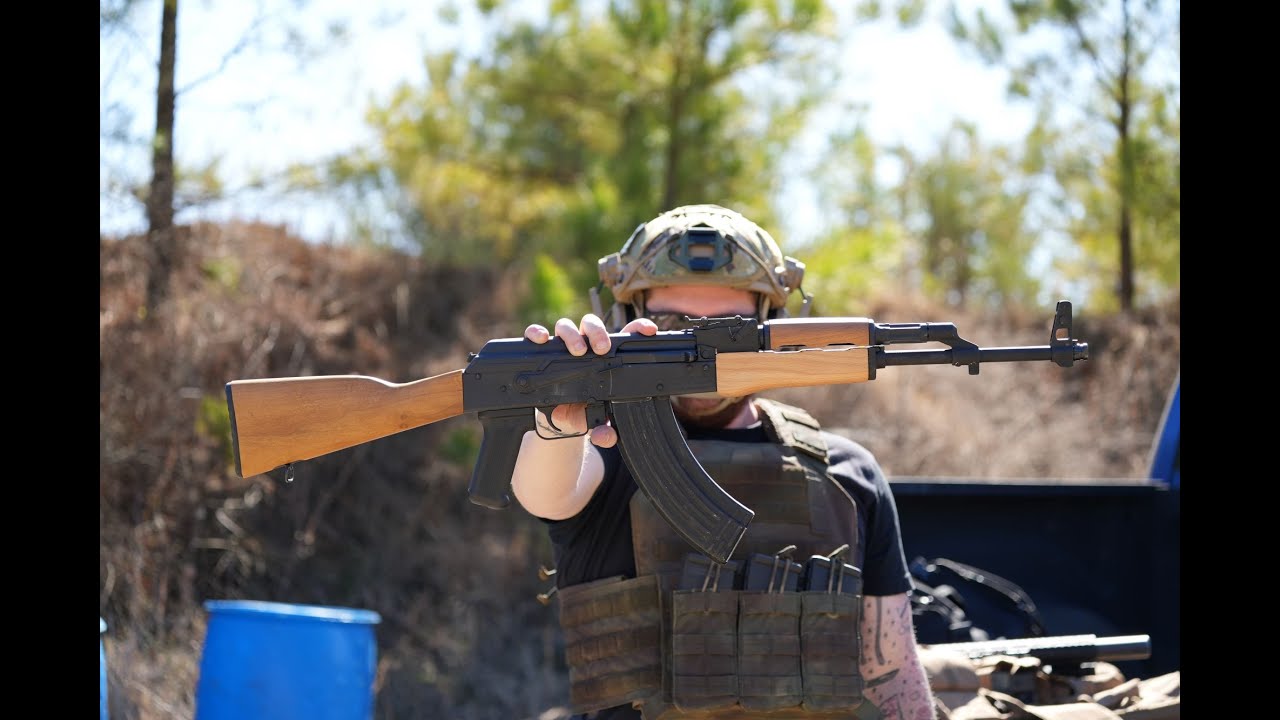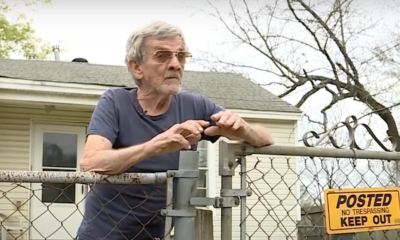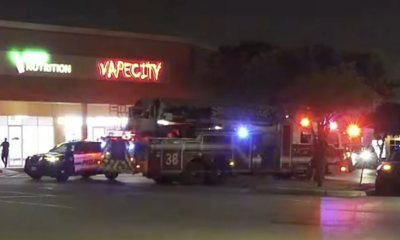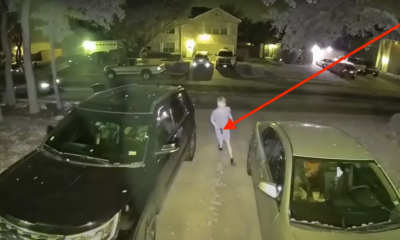Survival Stories
Trump Promises Gun Rights Protection at Pennsylvania NRA Event
In the bustling city of Harrisburg, Pennsylvania, a large crowd gathered last week to celebrate the Second Amendment and to hear from former President Trump at the NRA’s Great American Outdoor Show.
“Every single Biden attack on gun owners and manufacturers will be terminated on my very first week back in office, perhaps my first day,” Trump declared to an enthusiastic crowd at the Pennsylvania Farm Show Complex & Expo Center.
The NRA Presidential Forum, headlined by Trump, focused on the protection of the Second Amendment in this key battleground state. This marks the eighth time Trump has addressed NRA members, his speeches dating back to 2015. The Great American Outdoor Show, hosted by the NRA, is recognized as the world’s largest outdoor show, boasting over 1,000 exhibitors across 650,000 square feet of exhibit space during its nine-day run.
Trump made a promise to his supporters, stating that if he is reelected, “no one will lay a finger on your firearms.”
“I will uphold those glorious words: ‘shall not be infringed.’”
These comments come in the wake of President Biden and Vice President Harris’s repeated pledges to “take on the NRA” and ban what they refer to as assault weapons. Over the past three years, the president has signed numerous executive actions related to gun control, as well as the Bipartisan Safer Communities Act. The NRA did not support this act, citing its broad language and failure to address violent crimes.
Pennsylvania Republican Rep. Guy Reschenthaler spoke to Fox News Digital before Trump’s speech, expressing his belief that Democrats “don’t understand these platforms” of gun control and are aiming for “total government control.”
“The Democrats when they … openly now say that they want to take your AR, and we have candidates in Texas saying that Joe Biden has said that we don’t need the right to have these weapons,” he said. “They don’t understand these platforms, but at the root, they want to have total government control. And they don’t think individuals should have the right to carry, should have the right to have firearms. So, we have to always be focused on the Second Amendment and fighting to preserve our rights.”
Trump secured Pennsylvania in the 2016 election, but not in 2020. Pennsylvania Republican Rep. Scott Perry anticipates that Trump will make several visits to the state before Election Day 2024, noting the significant role gun owners will play in Trump’s potential victory.
“The president, I think, is going to spend a lot of time in Pennsylvania. It’s a battleground state. He needs to win Pennsylvania to win the rest of the country. He can win it. He’s won in the past, and we’re going to welcome him. … There’s a lot of gun owners in Pennsylvania, we understand where our rights come from and what protects them. So, it’s important to us,” Perry said in an interview.
Pennsylvania’s state Constitution states: “The right of the citizens to bear arms in defense of themselves and the State shall not be questioned.” Perry emphasized that in Pennsylvania, “We believe in the constitution.”
“The foundation of much of what was done during the Revolutionary War happened in Pennsylvania,” Perry said. “So, the Constitution, but more importantly what’s in it, is really important to us; and of course, our rights, ordained by God but enumerated in the Constitution. And all of those are protected by the Second Amendment. So, if you love the First Amendment, God bless you, the Fourth Amendment, God bless you – any one of them. If you love the document and what it says and the freedoms you have, back to the Second Amendment because that’s what preserves it. That’s what it means to us,” he said.
Reschenthaler referred to the state’s constitution protecting the right to bear arms as an “amendment that protects all the other amendments.”
“Pennsylvania has a robust [version] of the Second Amendment. In our Constitution, for example, it says … the right to self-defense shall not be questioned in Pennsylvania. So, starting off with that, you understand where the framers were with the Second Amendment and our right to carry and bear arms,” he said.
Reschenthaler, who represents Pennsylvania’s 14th Congressional District, stated that for his constituents, the Second Amendment is a top issue as crime trends rise.
“It’s incredibly important in my district to have the right to carry and to have arms, especially with the rising crime rates. You know, it’s amazing that the same people that walk around with their own private security are the ones that want to tell you that you don’t have the right to carry,” he said.
Perry urged every registered Republican in the Keystone State to vote this election year to bring about a national red wave.
“If every person that is registered to vote that’s a Republican, if every single one of them will vote, we will win easily. That’s all that needs to happen. If you are a registered Republican, just vote. You have 50 days in Pennsylvania now, there’s no reason, there’s no excuse not to vote. If you’re concerned about your rights, if you care about your rights, if you care about your country, your community, your safety, the safety of your family, your economic well-being, then you need to be voting,” he said.
After his speech at the NRA event, Trump headed to South Carolina. He will face off against former South Carolina Gov. Nikki Haley in the Republican primary this month. So far this primary season, Trump has won New Hampshire as well as the Iowa and Nevada caucuses.
Our Thoughts
The recent NRA event in Harrisburg, Pennsylvania, underscores the deep-seated passion many Americans have for the Second Amendment and their concern over potential infringements on their rights to bear arms.
Trump’s promise to terminate any attacks on gun owners and manufacturers if he returns to office taps into this sentiment and presents a stark contrast to the current administration’s stance on gun control.
The polarizing views on this issue between Republicans and Democrats are evident, with Representative Guy Reschenthaler’s comments pointing to a fundamental misunderstanding of gun control platforms on the part of the Democrats.
Whether this is an accurate depiction or a politically motivated critique, it highlights the ongoing struggle between individual liberties and perceived government overreach.
The role gun owners will play in the upcoming elections, particularly in key battleground states like Pennsylvania, cannot be underestimated.
Their potential influence on the election outcome underscores the need for ongoing, balanced discussions on the Second Amendment and its place in modern society.
It’s also a reminder that the Constitution remains a living document, one whose interpretation continues to evolve in response to societal changes and challenges.
Let us know what you think, please share your thoughts in the comments below.

Survival Stories
Lost and Found: GPS Technology in Wilderness Rescues

As someone who’s spent a fair bit of time in the great outdoors, I’ve learned a thing or two about the importance of navigation. Now, I’m not talking about the kind you use to find the nearest gas station on a road trip. I’m talking about the kind that can mean the difference between life and death when you’re stranded in the wilderness. And in this day and age, that means understanding GPS technology.
GPS, or Global Positioning System, is a network of satellites that orbit the Earth, transmitting signals that can be picked up by devices on the ground. These signals are used to calculate the device’s exact location, anywhere in the world. It’s a powerful tool, and it’s revolutionizing the way we approach wilderness rescues.
When you’re lost in the wilderness, every minute counts. The longer you’re exposed to the elements, the greater your risk of hypothermia, dehydration, and injury. Traditional search and rescue methods can take hours, even days, to locate a lost individual. But with GPS, rescuers can pinpoint a person’s location in a matter of minutes.
GPS technology is not just about speed, though. It’s also about accuracy. In dense forests or rugged mountain terrain, it’s easy for rescuers to miss a person, even if they’re just a few feet away. But with GPS, they can zero in on a person’s exact location, reducing the risk of a missed rescue.
But here’s the thing: GPS technology is only as good as the device it’s used on. That’s why it’s so important to have a reliable, high-quality GPS device when you’re venturing into the wilderness. And no, I’m not talking about the GPS on your smartphone. While that might be fine for city navigation, it’s not designed to withstand the rigors of the great outdoors.
When choosing a GPS device, there are a few key features to look for. First and foremost, it should be rugged and waterproof, able to withstand drops, dust, and water. It should also have a long battery life, as you never know how long you’ll need it. And it should have a clear, easy-to-read display, so you can quickly and easily read your coordinates, even in harsh lighting conditions.
Another important feature is the ability to send and receive messages. Some GPS devices come equipped with two-way satellite communication, allowing you to send an SOS signal and communicate with rescuers in an emergency. This feature can be a literal lifesaver, enabling you to convey vital information about your condition and situation.
It’s also worth considering a device with mapping capabilities. Detailed topographic maps can help you navigate unfamiliar terrain and plan the safest route. And with some devices, you can even download maps and updates via satellite, so you’re always equipped with the most up-to-date information.
But remember, while GPS technology is an incredible tool, it’s not a substitute for knowledge and skills. You should still learn how to read a map and compass, understand basic survival skills, and know what to do in an emergency. Because when it comes down to it, technology can fail, but your knowledge and skills can’t.
So, whether you’re a seasoned adventurer or a weekend hiker, don’t underestimate the power of GPS technology. It could be the difference between being lost and being found. But remember, it’s just a tool. The real key to survival is you.
Survival Stories
Unmasking WASR-10: Affordable, Reliable AK Variant Review

The world of AK variants is as diverse as it is contentious, with every gun enthusiast seeming to have a firm opinion on which model reigns supreme. Among the cacophony of voices, one recommendation often rings out: “Just get a WASR!”
The Romanian-made WASR series has carved out a niche in the U.S. imported firearms market, often hailed as the gold standard of affordable AKs available in the country. Century Arms, one of the largest firearms importers in the U.S., attributes much of its success to the “massive demand” for the WASR.
The question that remains is whether the WASR lives up to its legendary reputation. Is it the go-to AK variant for those on a budget? To answer these questions, we’ll delve into our experiences with the rack-grade WASR-10 in 7.62×39, from firing and handling to a thorough inspection by a qualified AK gunsmith.
The WASR series, imported by Century Arms, is built by Cugir Arms Factory in Cugir, Romania. The factory has a rich history, evolving from an iron-processing facility established in 1799 in the hills of Transylvania. The WASR-10 is essentially a semi-automatic version of the Pistol Mitralieră model 1963 (PM md. 63), a licensed version of the Soviet AKM. With its simple wood furniture and well-known design, these Romanian rifles are a no-frills variant of the AKM.
The WASR we have today is the result of years of improvements. One of the most significant upgrades is the elimination of “trigger slap” in current models through an aftermarket trigger. This issue, which involves the bolt slapping back into the hammer as it travels, impacting the disconnector/trigger and snapping it back into the shooter’s trigger finger, is thankfully uncommon in modern AKs like the current WASR-10 offerings from Century.
Before testing, we had local AK expert Josh from Copperhead USA in Tempe, Arizona, inspect our WASR. It’s important to remember that AKs often require real gunsmithing, unlike other platforms where swapping internal components is relatively straightforward. AK tolerances can vary greatly, even from the same factories at different times. If you’re considering delving deeper into the AK platform, investing time and money in learning to be competent rather than just enthusiastic is well worth it.
Our WASR-10 was in good shape when we unboxed it, as expected from a basic imported AK. However, AKs require many parts to be pressed and/or riveted together, and if done incorrectly, it can lead to serious issues down the line. Josh checked the headspace, as it’s possible for an AK to fire out of battery, which can cause serious problems. Our WASR was found to have good headspace after appropriate gauging. Josh also noted that it had a tight chamber, which we’ll discuss later. It’s not uncommon to find a canted (i.e., tilted) front iron sight post on an imported AK, but luckily, our WASR’s sights were fine.
The rest of the issues were purely cosmetic, but it’s important to have some knowledge of the platform to make those distinctions. The gas block was slightly canted, and the slant brake muzzle device didn’t sit flush on the muzzle due to the detent retaining it being slightly too long. It appeared the bolt carrier had been dropped at some point, as there was a small ding on the top of the carrier just forward of the recoil spring assembly. The safety was also remarkably tight, even after bending it out, which is another common issue with many AKs.
The wood furniture was nothing special; in fact, it even manifested some unexpected issues during testing. The trigger was a typical spongy AK trigger with a tactile reset and a curved bow. Based on everything we saw, this wasn’t a cherry-picked rifle and is a good measure of what you can expect from a WASR-10.
Testing was straightforward — the best way to test a new rifle is to fire it. In particular, firing an AK with a tight chamber helps fit the bolt to the chamber, reducing that issue. We loaded 500 rounds of Red Army Standard steel case 7.62×39 ammo into four different types of mags for our break-in range day. These included US PALM AK30R magazines, XTech MAG47 polymer magazines with steel locking lugs, Magpul MOE magazines, and Bulgarian steel 30-round mags from GunMag Warehouse.
The first mags of all four types presented no issues. However, the second XTech mag failed to feed on the last round, which also set the bullet back in the casing far enough to make us discard that round. Other than that, the only magazine issue we experienced was difficulty seating them, which is a combination of needing to break in the mag release lever and the mags themselves.
As we fired round after round, the rifle’s entire barrel and handguard were rippling with heat and smoke, but it kept going. After firing 500 rounds of steel-case ammo in less than 30 minutes during our aggressive break-in test, the WASR-10 held up remarkably well. Sure, it had a few minor issues out of the box, but most were purely cosmetic, and none would be insurmountable without a minor repair or continued use to break in the components.
With an MSRP of $1,070, the WASR-10 from Century Arms isn’t the cheapest AK you can buy, but it remains one of the best value-for-money options on the market. If you’re shopping for your first AK or simply want a reliable, durable rifle, it’s worth considering. However, if you’re expecting a flawless finish, 1 MOA accuracy, and the ability to add a modern sighting system without purchasing an aftermarket mount, you might want to consider a different AK or even a different platform altogether.
AKs continue to be a staple of the American firearms market, even as prices rise. If you’re looking for an affordable, reliable, and fun-to-shoot AK, the WASR-10 from Century is a solid choice. As it turns out, its reputation is well-deserved.
Our Thoughts
The WASR-10 is indeed an interesting piece of hardware. Its reputation as a budget-friendly yet reliable AK variant is well-earned, as our experience suggests. The Romanian roots and the long history of the Cugir Arms Factory lend an air of authenticity that is hard to ignore.
The AK platform is not without its challenges, as indicated by the need for real gunsmithing. That said, the WASR-10 seems to have overcome many of these issues, thanks to years of improvements. The elimination of the “trigger slap” is a significant enhancement, making the WASR-10 a more user-friendly option for AK enthusiasts.
We appreciate the thorough inspection by our local AK expert, Josh. It’s a reminder that a well-built AK requires careful assembly and the right expertise. The WASR-10 passed the test with flying colors, only showing minor cosmetic issues that don’t affect its functionality.
The WASR-10’s performance during testing was commendable, holding up well despite the aggressive break-in test. This robustness, coupled with its affordability, makes it an attractive option for those seeking a reliable AK variant.
It’s worth noting that the WASR-10 isn’t for everyone. If you’re after a flawless finish, pinpoint accuracy, or the ability to add a modern sighting system without additional expenditure, you might want to look elsewhere. However, for those seeking an affordable, reliable, and enjoyable AK experience, the WASR-10 is a solid choice, and its reputation is well-deserved.
Let us know what you think, please share your thoughts in the comments below.
Survival Stories
Master Urban Defense: Learn from History And Prepare for Future Wars

In the intricate dance of contemporary warfare, the urban landscape often serves as the stage. The past and present suggest that future conflicts will inevitably seep into the arteries of our cities, necessitating a deep understanding of urban defense strategies. This notion is investigated by John Spencer and Jayson Geroux of the Modern War Institute at the West Point Military Academy. They assert, “if leveraged effectively, a solid urban defense can decisively tip the scales of war.”
Urban environments are complex mazes of buildings, streets, and alleys, creating a unique battlefield that differs greatly from open fields or forests. Historic urban battles, such as the renowned Battle of Stalingrad or the struggle for Mosul, provide valuable lessons on effective urban defense. The key lies in preparation, strategic planning, and the ability to swiftly adapt tactics as situations evolve.
Narrow urban pathways, such as alleys, can serve as choke points, disrupting the advance of an enemy force and potentially providing an opportunity to employ massing effect strategies.
When devising a defense strategy for a city, there are several key tactics derived from military guides and historical precedents:
* Disruption: This strategy involves fracturing the unity of the enemy’s forces, hindering their ability to effectively execute their plans. In urban settings, disruption can be achieved by manipulating the terrain to divide enemy units, impair their communications, and disrupt their logistics, effectively slowing their momentum and making them more susceptible to counteractions.
* Massing Effects: This principle refers to the concentration of combat power at the right place and time to achieve maximum impact. In urban defense, massing effects might involve concentrating firepower in an area likely to be breached by the enemy or organizing forces discreetly for a surprise counterattack against an advancing adversary.
* Flexibility: A crucial element of any successful defense, flexibility refers to the ability to rapidly adapt to changing circumstances. This includes altering tactics in response to enemy movements, repositioning forces to exploit newly identified weaknesses in the enemy’s approach, and adapting defensive measures to accommodate the evolving urban landscape.
Urban centers are filled with potential resources to create obstructions to enemy movements.
Examining how soldiers defended “Pavlov’s House” in Stalingrad or utilized ruined buildings in Ortona provides valuable insights for modern urban defense.
As the nature of warfare evolves, so must our methods of defending cities. Combining time-tested strategies with modern technology will prepare us for future conflicts. Cities offer a multitude of ways to protect and defend, and leveraging lessons from the past will aid in devising intelligent plans for future conflicts.
This knowledge is not only vital for military commanders, but the skills and tactics involved in urban defense are also invaluable to civilians attempting to survive amidst conflict. This was explored in Selco Begovic’s interview recorded in the SHTF Anthology, which underscores the importance of understanding and mastering urban defense.
Defending a city requires as much intellectual prowess as physical strength. Urban defense is a blend of art and science, demanding a comprehensive understanding of both the physical and historical landscapes of urban combat. Looking forward, the lessons gleaned from past urban battles, combined with a solid grounding in military doctrine, will equip today’s defenders with the strategies necessary to secure victory.
Our Thoughts
The urban landscape’s complexity indeed presents a unique battlefield, as the article rightly suggests. The notion of urban defense is not just a military strategy; it’s a survival skill that could prove vital for civilians caught in the throes of conflict.
The key elements of disruption, massing effects, and flexibility are fundamentally sound strategies. Disruption, in particular, resonates with our survivalist ethos, as it mirrors the idea of using the environment to your advantage.
However, the article’s emphasis on the importance of historical precedents is crucial. The Battle of Stalingrad, the struggle for Mosul, and the defense of “Pavlov’s House” offer invaluable lessons that can be applied in modern urban defense strategies.
The idea of blending time-tested strategies with modern technology is intriguing. As we often advocate, the best survival strategies combine traditional wisdom with modern advancements.
Finally, the assertion that defending a city requires intellectual prowess as much as physical strength aligns perfectly with our belief that survival is as much a mental game as it is a physical one.
In conclusion, the article offers a compelling exploration of urban defense that resonates with our survivalist mindset. It reiterates the importance of being prepared, adaptable, and resourceful—principles that are the very essence of survivalism.
Let us know what you think, please share your thoughts in the comments below.
-

 Tactical2 years ago
Tactical2 years ago70-Year-Old Fends Off Intruder with Lead-Powered Message
-

 Tactical2 years ago
Tactical2 years agoVape Shop Employee Confronts Armed Crooks, Sends Them Running
-

 Preparedness1 year ago
Preparedness1 year agoEx-Ballerina’s Guilty Verdict Sends Tremors Through Gun-Owner Community
-

 Off The Grid2 months ago
Off The Grid2 months ago10 Foods That Could Save Your Life When Grocery Shelves Are Empty
-

 Preparedness1 year ago
Preparedness1 year agoGood Samaritan Saves Trooper in Harrowing Interstate Confrontation
-

 Nature and Wildlife1 month ago
Nature and Wildlife1 month ago10 Survival Skills You Should Learn Before You Need Them
-

 Tactical2 years ago
Tactical2 years agoMidnight SUV Theft Interrupted by Armed Homeowner’s Retaliation
-

 Preparedness5 months ago
Preparedness5 months agoHow Much Gasoline Should You Store for Emergencies?
